Ford Fairlane (Americas)
| Ford Fairlane | |
|---|---|
 1962 Ford Fairlane Town Sedan | |
| Overview | |
| Manufacturer | Ford |
| Production | 1955–1970 |
| Assembly |
Edison, New Jersey, United States Claycomo, Missouri, United States Milpitas, California United States[1] |
| Body and chassis | |
| Class | Full-size (1955–1961), Mid-size (1962–1970) |
| Body style |
two-door hardtop two-door convertible two-door sedan four-door sedan four-door hardtop two-door station wagon (1964 only)[2] four-door station wagon |
| Layout | FR layout |
| Chronology | |
| Successor | Ford Torino |
The Ford Fairlane is an automobile model that was sold between 1955 and 1970 by Ford in North America. The name is derived from Henry Ford's estate, Fair Lane, near Dearborn, Michigan.
Over time, the name referred to a number of different cars in different classes; the Fairlane was initially a full-sized car, but became a mid-sized car from the 1962 model year. The mid-sized model spawned the Australian-built Fairlane in 1967, although in that market it was considered a large car.
First generation (1955–1956)
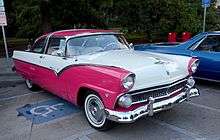
For the 1955 model year the Fairlane name replaced the Crestline as Ford's premier full-sized offering. Six different body styles were offered, including the Crown Victoria Skyliner with a tinted, transparent plastic roof, the regular Crown Victoria coupe with lots of stainless steel trim, a convertible Sunliner, the Victoria hardtop coupe, and traditional sedans. All featured the trademark stainless-steel "Fairlane stripe" on the side. Power options were a 223 cu in (3.7 L) straight-6 engine and a 272 cu in (4.5 L) V8. The 292 cu in (4.8 L) Y-block was offered as an option and was called the Thunderbird V-8.
Few changes were made for 1956; a four-door Victoria hardtop and two new, more powerful V8 options, of 292 cu in (4.8 L) and 312 cu in (5.1 L), the latter available up to 225 bhp (168 kW; 228 PS), were introduced. The Lifeguard safety package was introduced. The two-door Victoria hardtop featured a new and slimmer roofline. A one-year only two-door station wagon, the 1956 Ford Parklane, featured Fairlane-level trim. It was marketed to compete against the Chevrolet Nomad.
 1955 Ford Fairlane Town Sedan
1955 Ford Fairlane Town Sedan- 1955 Ford Fairlane Sunliner
Second generation (1957–1959)
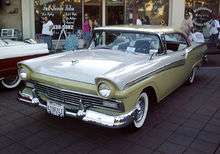
For 1957, a new style gave a longer, wider, lower, and sleeker look with low tailfins. The new proportions and modern styling were a hit with customers to the extent that the Ford outsold Chevrolet in 1957 for the first time since 1935.[3] A new top trim level was reversed, the Fairlane 500. For the first time, the lower-level Custom line had a shorter wheelbase than the Fairlane. Engines were largely the same as the year before. The big news for 1957 was the introduction of the Fairlane 500 Skyliner power retractable hardtop, whose solid top hinged and folded down into the trunk space at the touch of a button.
Another facelift for 1958 had fashionable quad headlights, a grille that matched the 1958 Thunderbird, and other styling changes. New big-block FE V8s of 332 and 352 CID (5.4 L and 5.8 L) replaced the previous largest V8s, and a better three-speed automatic transmission was also available.
A new top-level full-sized model was introduced at mid-year 1959, the Ford Galaxie. The 1959 Galaxie displayed both "Fairlane 500" and "Galaxie" badging.[4]
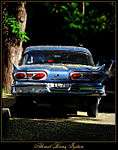 1958 Ford Fairlane 500
1958 Ford Fairlane 500 1958 Ford Fairlane 500 Skyliner
1958 Ford Fairlane 500 Skyliner 1958 Ford Fairlane 500 Club Victoria
1958 Ford Fairlane 500 Club Victoria 1958 Ford Fairlane 500 Skyliner
1958 Ford Fairlane 500 Skyliner 1959 Ford Fairlane 500 Skyliner
1959 Ford Fairlane 500 Skyliner- 1959 Skyliner, the Ford Galaxie models displayed both "Fairlane 500" and "Galaxie" badges
Third generation (1960–1961)
| Third generation | |
|---|---|
 1960 Ford Fairlane 500 Town Sedan | |
| Overview | |
| Production | 1959 to 1961 |
| Body and chassis | |
| Body style |
two-door sedan four-door sedan |
| Related |
Ford Ranch Wagon Ford Country Sedan |
| Dimensions | |
| Wheelbase | 119 in (3,023 mm) |
Full-sized Fairlane and Fairlane 500 models were restyled for 1960 and again for the 1961 model year. The Galaxie series continued as the top-of-the-line full-sized Ford. Fairlane 500s demoted to mid-level in the lineup and were equivalent to the Chevrolet Bel Air. Fairlanes were primarily sold as base level trim models for fleet use (taxi, police). Both were now only available as pillared sedans.
The big-block 390 CID V8 was available in 1961 as the top-horsepower option, as the "horsepower wars" in Detroit continued.[5][6]
 1960 Ford Fairlane Club Sedan
1960 Ford Fairlane Club Sedan
Fourth generation (1962–1965)
| Fourth generation | |
|---|---|
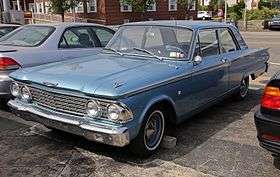 1962 Ford Fairlane 500 Club Sedan | |
| Overview | |
| Production | 1962–1965 |
| Assembly |
Edison, New Jersey Lorain, Ohio Milpitas, California Canada Australia[7] Seaview, Wellington, New Zealand[8] |
| Body and chassis | |
| Body style |
two-door hardtop two-door sedan four-door sedan two-door station wagon (1964 only)[2] 4-door station wagon |
| Related | Mercury Meteor |
| Powertrain | |
| Engine |
2.8L I6 3.6 L V8 4.3 L V8 |
| Transmission |
two-speed automatic three-speed automatic three-speed manual four-speed manual |
| Dimensions | |
| Wheelbase | 2,934 mm (115.5 in) |
| Length | 5,004 mm (197.0 in)[9] |
The Fairlane name was moved to Ford's new intermediate, introduced for the 1962 model year, to bridge the gap between the compact Ford Falcon and the full-sized Galaxie, making it a competitor for GM's A-body "senior compacts", the Dodge Custom 880, and the AMC Rambler. With an overall length of 197 in (5004 mm) and a wheelbase of 115.5 in (2934 mm), it was 16 in (406 mm) longer than the Falcon and 12.3 in (312 mm) shorter than the Galaxie. Wheel track varied from 53.5 in (1355 mm) to 56 in (1422 mm) depending on model and specification.
Like the Falcon, the Fairlane had a unibody frame, but the body incorporated an unusual feature Ford dubbed torque boxes, four boxed structures in the lower body structure designed to absorb road shock by moving slightly in the vertical plane. Suspension was a conventional short-long arm independent arrangement in front, with Hotchkiss drive in the rear. The Fairlane was initially offered only in two-door or four-door sedan body styles.
The Fairlane's standard engine was the 170 CID (2.8 L) six, but as an option, it introduced Ford's new, lightweight Windsor V8, initially with a displacement of 221 CID (3.6 L) and 145 hp (108 kW); a 260 CID (4.2 L) "Challenger" version was added at mid-year, with an advertised 164 hp (122 kW). The Sports Coupe option débuted mid-year and featured bucket seats and a small floor console. The trim level supplemented the Fairlane and Fairlane 500 trim levels (the 500 model had more decorative trim, such as a wider chrome stripe down the side and three bullets on the rear quarter panels). The Challenger 289 CID engine was introduced in mid-1963, with solid lifters and other performance pieces helping the engine produce an advertised 271 hp (202 kW); however, it was equipped with single exhaust like the less powerful engines. This engine was coded "K" in the vehicle identification number. Exterior identification was by fender-mounted "V" badges that read "289 High Performance". That same year, station wagons arrived, called the Ranch Wagon and Ranch Custom Wagon. All 1962 Fairlanes had "B" posts despite the popularity of the pillarless hardtop and convertible styles in that era.
Ford saw the problem and introduced two pillarless hardtop coupes for 1963, in Fairlane 500 and Sports Coupe trim. For 1963 and later Sports Coupe models, the center console, which had come from the Falcon parts bin for 1962, was changed to be similar to that of the Galaxie. Front-end styling for the 1963 models mimicked the big Galaxie models, but the rear end retained the small tailfins and "pieplate" tail lamp styling cues. The Squire wagon (a fake woodie) was available for 1963 only, including one model with front bucket seats. The "Swing-Away" steering wheel became an option in 1964.[10]
The 1964 and 1965, Fairlane ranges consisted of similar body styles: base Fairlane and Fairlane 500 two-door coupes and four-door sedans, and Fairlane 500 and Sports Coupe two-door hardtops. The Fairlane Squire wagon was dropped, but the standard station wagon was continued. The 221 V8 was dropped after 1963, leaving the six as the base engine and the 260 as the base V8. The "K-code" 271-horsepower 289 V8 continued into 1964, gaining dual exhausts, while a 195 horsepower (145 kW) version of the 289 with a two-barrel carburetor and hydraulic lifters was introduced. The two-speed Fordomatic continued as the automatic transmission choice for the 260 in 1964, while 289 V8s got the three-speed Cruise-O-Matic transmission option. All 1965 models featured 14-inch (360 mm) wheels as standard, in place of the earlier 13-inch (330 mm) wheels, and Fordomatic was finally phased out, leaving the Cruise-O-Matic as the only automatic available for the Fairlane. The 260 was also dropped after 1964, leaving the two-barrel 289 as the base V8. Styling-wise, in 1964, a new grille and headlight bezels were introduced, the tail fins were dropped, some chrome decorating on the side was changed, and the shape of the trunk lid changed. Styling features for 1965 included body-color headlight bezels for the deluxe models and rectangular taillight lenses, a return to the 1962-1963 trunk lid, along with less chrome on the body and a small standup hood ornament.
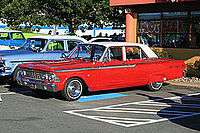 1962 Ford Fairlane 500 Town Sedan
1962 Ford Fairlane 500 Town Sedan 1963 Ford Fairlane 500 Custom Ranch Wagon
1963 Ford Fairlane 500 Custom Ranch Wagon.jpg) 1964 Ford Fairlane 500 Sports Coupe
1964 Ford Fairlane 500 Sports Coupe- 1965 Ford Fairlane 500 2-Door Sedan
- 1965 Ford Fairlane 500 2-Door Sedan
Thunderbolt
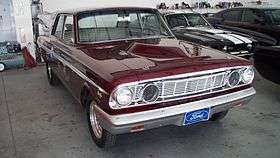
As the muscle car market took shape, Ford introduced a Ford Fairlane in 1963 [a few Fairlane two door hard tops] were perpaired for drag racing during the 1963 season. These cars were running the 289 [one is known that ran the 260 and there could have been more] and were set up in the Tubing works plant that built the special cars for Ford racing. These soon evolved into the "Thunderbolts" for 1964. Thunderbolt for drag racing for 1964, was a heavily modified two door post to incorporate Ford's new 427 CID (7.0 L) V8 race engine with two four-barrel carburetors on a high-riser manifold, ram-air through the openings left by deleting the inboard headlights, equal-length headers, trunk-mounted battery, fiberglass hood, doors, fenders, and front bumper, acrylic glass windows, and other lightweight options, including deleted rear-door window winders, carpeting, radio, sealant, sun visors, armrests, jack, lug wrench, heater, soundproofing, and passenger-side windshield wiper. The cars wore Fairlane 500 trim, and were only offered with the two-door sedan body. This special model, of which 111 to 127 total were made (sources disagree), delivered 657 hp (490 kW) at 7,500 rpm[11] and was known as the Thunderbolt.
Racing in NHRA Super Stock class on 7-inch (180 mm)-wide tires, the Thunderbolt was based on the midlevel Fairlane 500 two-door pillared sedan, and in 1964 set elapsed time and top speed records at 11.6 seconds and 124 mph (200 km/h).[12] took the Super Stock title, and won the Manufacturer's Cup. The car as delivered was slightly too light to meet NHRA's 3200-lb (1451-kg) minimum weight unless it was raced with a full tank of gasoline, which would bring it to 3203 lb (1453 kg). NHRA rules at the time required a metal front bumper, so the cars began to be supplied with an aluminum bumper and previous purchasers were supplied with one.
Thunderbolt production was ended due to NHRA rule changes for Super Stock competition, requiring that 500 vehicles be built to be entered in that class. Ford had been losing $1500 to $2000 on each Thunderbolt sold at the sticker price of $3900. The first 11 Thunderbolts were painted maroon (known as Vintage Burgundy in Ford literature), the rest white; 99 had manual transmissions. Many are still raced. About 50 similar Mercury Cyclones were also produced by Ford in 1964, destined to be modified to represent Ford in A/FX competition, which they dominated, as well. These vehicles varied greatly in wheel track due to customer options for varing suspension and wheel/tire combinations. Front tracks from 54 to 56 in and rear tracks from 53.5 to 55.5 in were common.
Fifth generation (1966–1967)
| Fifth generation | |
|---|---|
.jpg) 1966 Ford Fairlane 500 Club Coupe | |
| Overview | |
| Production | 1966–1967 |
| Assembly |
Edison, NJ Lorain, OH Milpitas, CA Atlanta, GA |
| Body and chassis | |
| Body style |
two-door coupe two-door convertible two-door sedan four-door sedan four-door station wagon |
| Related |
Ford Ranchero Mercury Comet |
| Powertrain | |
| Engine |
200 cu in (3.3 L) I6 390 cu in (6.4 L) V8 289 cu in (4.7 L) V8 302 cu in (4.9 L) V8 427 cu in (7.0 L) V8 |
| Transmission | 3-speed manual, 4-speed manual, 3-speed "Cruise-O-Matic", optional overdrive |
| Dimensions | |
| Wheelbase |
116.0 in (2,946 mm) 113.0 in (2,870 mm) (wagon) |
| Length | 197 in (5,004 mm) |
| Width | 74.4 in (1,890 mm) |
| Curb weight | 2,747–3,493 lb (1,246–1,584 kg) (six cylinder coupe - GT Coupe) |
The Fairlane was revised in 1966.[13] The appearance was changed to match the full-sized Ford, which had been restyled in the 1965 model year. The front end featured vertically stacked dual headlights. The XL, GT, and GTA packages were introduced, as well as a convertible to join the existing range of sedans, hardtops, and station wagons. The "K-code" 289 CID engine was dropped this year. The GT featured a 390 CID FE V8 as standard, while the GTA also included the newly introduced the SportShift Cruise-o-Matic automatic transmission. The GT/GTA 390 CID engine developed 335 bhp (250 kW) with higher compression, and had a four-barrel carburetor. Mid year, Ford produced 57 special Fairlane 500 two-door hardtops with "R-code" 427 CID V8s rated at 425 bhp (317 kW) and equipped with Ford's "Top-Loader" four-speed manual transmission. Built to qualify the engine/transmission combination for NHRA and IHRA Super Stock racing, they were white and had fiberglass hoods with a forward-facing hood scoop which ended at the edge of the hood. The Fairlane Squire wagon was reintroduced for 1966.
Minor trim changes were introduced for 1967 as the Fairlane was mildly facelifted. The 289 CID small-block became the base V8, with a 200 CID six standard, with the 390 CID optional (with either two- or four-barrel carburetor, at 275 and 320 bhp (240 kW), respectively). The 427s were still available, either with a single four-barrel carburetor or dual quad carbs, developing 410 (W-code) and 425 bhp (R-code), 427s were available on XL models, but very few were built. The notable addition for the 1967 model year was a Ranchero pickup as part of the Fairlane range (from 1960 to 1965, the Ranchero was based on the Falcon, while in 1966 it used the Fairlane platform but Falcon styling). The 1967 Fairlanes also included a number of federal government-mandated safety features, including a new energy-absorbing steering column with a large padded steering wheel hub, soft interior trim, four-way hazard flashers, a dual-chamber braking system, and shoulder belt anchors. The convertible had a tempered safety glass rear window.[14]
The Falcon Ranchero and Falcon station wagon were, between 1966 and 1970, identical under the skin to the Fairlane versions of the same model. Only sheetmetal and trim differed.
Two different two-door coupe models were offered. The lower-end Fairlane Club Coupe had pillars around the rear windows, while the higher trim level was a pillarless two-door hardtop, similar to the convertible.
.jpg) 1966 Ford Fairlane 500 4-Door Sedan
1966 Ford Fairlane 500 4-Door Sedan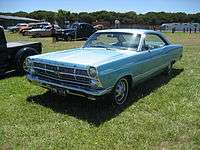 1967 Ford Fairlane 500 Hardtop
1967 Ford Fairlane 500 Hardtop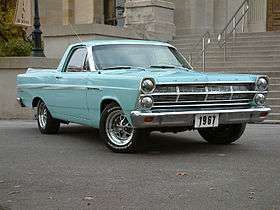 1967 Ford Fairlane Ranchero
1967 Ford Fairlane Ranchero
Sixth generation (1968–1969)
| Sixth generation | |
|---|---|
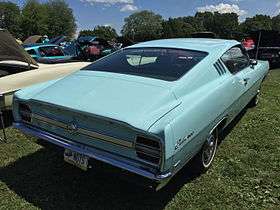 1969 Ford Fairlane 500 Sportsroof | |
| Overview | |
| Production |
1968–1969 (North America) 1969–1981 (Argentina) |
| Assembly |
Edison, New Jersey Lorain, Ohio Milpitas, California General Pacheco, Argentina |
| Body and chassis | |
| Body style |
two-door coupe two-door convertible two-door sedan four-door sedan four-door station wagon |
| Related |
Ford Torino Ford Ranchero Mercury Comet Mercury Cyclone |
| Powertrain | |
| Engine |
200 cu in (3.3 L) I6 289 cu in (4.7 L) V8 302 cu in (4.9 L) V8 390 cu in (6.4 L) V8 428 cu in (7.0 L) V8 |
| Dimensions | |
| Wheelbase |
116.0 in (2,946 mm) 113.0 in (2,870 mm) (wagon) |
A redesign was introduced for the 1968 model year. The wheelbase remained at 116 in (2,946 mm), but it grew in other dimensions. They were about four inches (102 mm) longer and 200 lb (91 kg) heavier than the cars they replaced.[15] A fastback Sportsroof model was introduced in the Fairlane 500 series, as well as a more luxurious Torino model at the top of the intermediate range, contributing 172,083 of the Fairlane's 371,787 units sold that year.[16]
In a cost-saving decision, the station wagons carried over the 1966-67 bodies from the cowl back.[15] The Ranch Wagon model name was deleted; Fairlane wagons had either the base or the 500 trim. Base hardtop sales more than doubled, to 44,683 units.[17]
The base engine was the 200 cu in (3.3 L) I6, with several optional V8s. Early production 1968 base V8 Fairlanes were equipped with the two-barrel 289 cu in (4.7 L), while later units came with the 302 cu in (4.9 L).[18] The GTs were part of the Torino range, with the 302 CID V8 standard, with optional engines being the 390 CID V8 in two- and four-barrel versions. The 390 four-barrel was supplanted mid-year as the top performance engine by the 428 cu in (7.0 L) Cobra Jet, developing 335 bhp (250 kW). There was also a 428 cu in (7.0 L) Super Cobra Jet.
The Ranchero coupe utility body style was available in standard, 500, and GT versions.
The Cobra was introduced in 1969 as a competitor for Plymouth's Road Runner. Basic models featured the 302 CID V8 and three-speed manual transmission as standard. Options included the 390 CID and two 428 cu in (7.0 L) V8s. The Cobras had a standard 428 CID V8 rated at 335 bhp (250 kW), while options included bucket seats, hood scoop, clock, tachometer, power disc brakes, and 4.30:1 rear axle gearing. "Regular" Fairlanes and Rancheros continued, all with bucket-seat options.
.jpg) 1969 Ford Fairlane 4-Door Sedan
1969 Ford Fairlane 4-Door Sedan 1969 Ford Fairlane Convertible
1969 Ford Fairlane Convertible
Seventh generation (1970)
| Seventh generation | |
|---|---|
| Overview | |
| Production | 1970 |
| Assembly |
Edison, New Jersey Lorain, Ohio Milpitas, California |
| Body and chassis | |
| Body style |
two-door coupe two-door convertible two-door sedan four-door sedan four-door station wagon |
| Related |
Ford Ranchero Ford Torino Mercury Comet Mercury Montego |
| Powertrain | |
| Engine |
250 cu in (4.1 L) I6 302 cu in (4.9 L) Windsor V8 351 cu in (5.8 L) Windsor V8 351 cu in (5.8 L) Cleveland V8 429 cu in (7.0 L) 385 Series V8 |
| Dimensions | |
| Wheelbase |
117 in (2,972 mm) 114 in (2,896 mm) (wagon) |
Ford's intermediates grew again in 1970, now with a 117 in (2,972 mm) wheelbase. At the start of the model year, only the Fairlane 500 remained as the base trim model in what was now effectively the Torino series.
The straight six-cylinder was the economy power, while largest engine was now a 429 cu in (7.0 l) with four-barrel carburetor and 360 bhp (270 kW), on the Torino Cobra. Different heads were optional and gave the Cobra 370 bhp (280 kW) and higher compression. Other options included the Cobra Jet Ram Air 429, though Ford quoted the same power output, and the Drag Pack rated at 375 bhp (280 kW). However, the 1970s were slower than the 1969s, and race teams were forced to run the older models.
The Falcon name was transferred from Ford's now discontinued, in the US, compact to a basic, even lower-trim version of the intermediate platform as a "1970½" model on January 1, 1970. This series included a two-door sedan which was not available in the higher trim lines. For 1971, the Falcon and Fairlane 500 names were dropped, as all of the intermediate models took the Torino name. The Falcon and Fairlane names continued to be used in Australia through to the 21st century.
.jpg) The 1970½ Ford Falcon 2-Door Sedan. The 1970½ Falcon was a low-priced version of the 1970 Fairlane 500.
The 1970½ Ford Falcon 2-Door Sedan. The 1970½ Falcon was a low-priced version of the 1970 Fairlane 500.
Ford Fairlane in Argentina
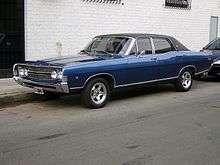
The four-door sedan of the 1968 body style was built in Argentina from 1969 to 1973 and the 1969 body style from 1973 to 1981 under the Fairlane name with three equipment packages: Standard, 500 and LTD. The car was similar to the American model except the engines. The two options were a 221 CID 6-cylinder with 132 hp (98 kW), and the old 292 phase I (1969-1971) CID "Y-block" V8 which had been last used in the 1964 F-Series truck; it was rated at 185 hp (138 kW),in 1971 the Ford Motor Company Argentina decided to make an improvement on the 292, was started by the covers mainly the problem of spark plugs was solved by giving an inclination towards the front of the engine that allowed an easier extraction in the car, changed the opening order and exhaust cam, valves larger intake (of the 292 heavy duty American) were placed, fuel lines making them more direct was improved with a new admission very similar to that of the small block 289, 302 pistons maximum compression with lomo brand Buxton were used, raising the compression at 8 to 1, allowing the engine erogue 185 HP at 4500 rpm, another improvement were leaks with individual manifold runners, eliminating the original American system of a manifold connected to another in series, used in trucks, in cars they were always individual. Distributors are different in coupling, calling FASE II . In 1978, the LTD "Elite" option was introduced as the most luxurious made in Argentina. By the end of production in 1981, almost 30,000 Fairlanes had been made.[19]
2005 concept
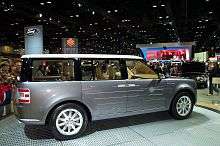
At the 2005 Auto Show circuit, Ford revealed a new concept car with the Fairlane nameplate.[20] The "people-mover" Fairlane crossover utility vehicle concept featured three-row seating for six passengers, and previewed the chromed three-bar horizontal grill design, which currently appears on the 2006 Ford Fusion sedan and 2007 Ford Edge crossover utility vehicle."[21][22]
Production model
- See Ford Flex
A production version of the Fairlane concept, now called the Ford Flex, debuted at the 2007 New York Auto Show, and entered production for the 2009 model year in summer 2008. Unlike the concept, the production model comes with seven seats. It is built on the Ford D3 platform, which is also used by the Ford Taurus, and Mercury Sable. It is intended to replace the people-mover capability of the Ford Freestar minivan.[23][24]
References
- ↑ "Facilities | Ford Motor Company Newsroom". Media.ford.com. Retrieved 2010-10-19.
- 1 2 Gunnell, John (2002). Standard Catalog of American Cars, 1946-1975 (Fourth ed.). p. 414.
- ↑ "Archived copy". Retrieved August 2, 2015.
- ↑ "the '59 Fords (US sales mailer)". oldcarbrochures.com. Retrieved 29 March 2016.
- ↑ Ford 1960 Brochure "1960 Fords". Ford Motor Company
- ↑ Ford 1961 Brochure "1961 Fords". Ford Motor Company
- ↑ Bruce McColl, The Compact Fairlane Story, Restored Cars, Number 121, Mar-Apr '97, pages 38-42
- ↑ Webster, Mark (2002), Assembly: New Zealand Car Production 1921-98, Birkenhead, Auckland, New Zealand: Reed, p. 80f, ISBN 0-7900-0846-7
- ↑ "1962 Ford Full Size Brochure". Oldcarbrochures.com. Retrieved 29 March 2016.
- ↑ "1964 Ford brochure 1". Oldcarbrochures.com. Retrieved 2011-11-20.
- ↑ Ford FE engine
- ↑ Adolphus, David Traver (August 2008). "1964 Ford Fairlane 500 Thunderbolt". Hemmings Muscle Machines. Retrieved 29 March 2016.
- ↑ Gunnell, John (1 April 2002). Standard Catalog of American Cars, 1946-1975. Krause Publications. ISBN 978-0-87349-461-8. Retrieved 24 February 2013.
- ↑ "1967 Ford Full Line Brochure". Oldcarbrochures.com. p. 9. Retrieved 29 March 2016.
- 1 2 Grey, Jim (March 23, 2013). "1968 Ford Fairlane GT – The Unexpected Wallflower". Curbside Classic. Retrieved October 3, 2015.
- ↑ Flory, J. "Kelly", Jr. (2004). American Cars 1960-1972. McFarland. p. 599.
- ↑ Flory, p.599.
- ↑ "Fairlane Registry 1968 VIN Codes". FordFairlane.com. Retrieved 2010-10-19.
- ↑ "Fairlane Argentina 2.0" (in Spanish). www.fairlaneargentina.com. Retrieved 29 March 2016.
- ↑ "2005 Chicago Auto Show: Ford Fairlane Photo Gallery." Motor Trend, 2005.
- ↑ Nevin, Brad. "Ford Fairlane Breaks New Ground as a People Mover." Ford Communications Network, 9 December 2005.
- ↑ "Ford Fairlane Concept." Automobile Magazine, 2005.
- ↑ "Ford OKs Fairlane, Keeps Town Car". Ward's AutoWorld. 1 October 2006. Retrieved 29 March 2016.
- ↑ "Ford Develops People Movers to Replace Minivans." Car and Driver.
External links
| Wikimedia Commons has media related to Ford Fairlane. |
- Ford Fairlane at the Internet Movie Cars Database
| « previous — Ford car timeline, North American market, 1946–1979 — next » | ||||||||||||||||||||||||||||||||||
|---|---|---|---|---|---|---|---|---|---|---|---|---|---|---|---|---|---|---|---|---|---|---|---|---|---|---|---|---|---|---|---|---|---|---|
| Type | 1940s | 1950s | 1960s | 1970s | ||||||||||||||||||||||||||||||
| 6 | 7 | 8 | 9 | 0 | 1 | 2 | 3 | 4 | 5 | 6 | 7 | 8 | 9 | 0 | 1 | 2 | 3 | 4 | 5 | 6 | 7 | 8 | 9 | 0 | 1 | 2 | 3 | 4 | 5 | 6 | 7 | 8 | 9 | |
| Subcompact | Pinto | |||||||||||||||||||||||||||||||||
| Fiesta | ||||||||||||||||||||||||||||||||||
| Compact | Falcon | Falcon | Falcon | |||||||||||||||||||||||||||||||
| Maverick | Fairmont | |||||||||||||||||||||||||||||||||
| Granada | ||||||||||||||||||||||||||||||||||
| Mid-size | Falcon 70½ | |||||||||||||||||||||||||||||||||
| Fairlane | Fairlane | Fairlane | Fairlane | |||||||||||||||||||||||||||||||
| Torino | Torino | Torino | LTD II | |||||||||||||||||||||||||||||||
| Full-size | Deluxe | Ford | Deluxe | Mainline | Mainline | |||||||||||||||||||||||||||||
| Super Deluxe | Custom Deluxe | Customline | Customline | Custom | 300 | Custom | Custom | Custom | ||||||||||||||||||||||||||
| Crestline | Fairlane | Fairlane | Fairlane | |||||||||||||||||||||||||||||||
| Galaxie | Galaxie | Galaxie | Galaxie | |||||||||||||||||||||||||||||||
| XL | XL | |||||||||||||||||||||||||||||||||
| LTD | LTD | LTD | ||||||||||||||||||||||||||||||||
| Station wagon | Parklane | Del Rio | ||||||||||||||||||||||||||||||||
| Ranch Wagon | Ranch Wagon | Ranch Wagon | Ranch Wagon | Ranch Wagon | Ranch Wagon | |||||||||||||||||||||||||||||
| Country Sedan | Country Sedan | Country Sedan | Country Sedan | Country Sedan | ||||||||||||||||||||||||||||||
| Country Squire | Country Squire | Country Squire | Country Squire | Country Squire | Country Squire | |||||||||||||||||||||||||||||
| Personal luxury | Thunderbird | Thunderbird | Thunderbird | Thunderbird | Thunderbird | Thunderbird | Thunderbird | |||||||||||||||||||||||||||
| Sports | Thunderbird | Mustang | Mustang | Mustang | ||||||||||||||||||||||||||||||